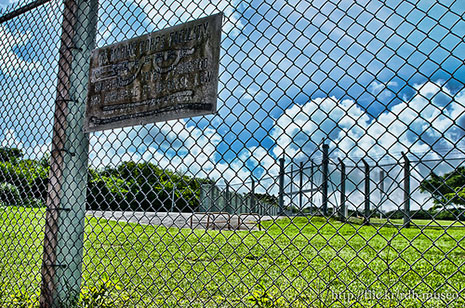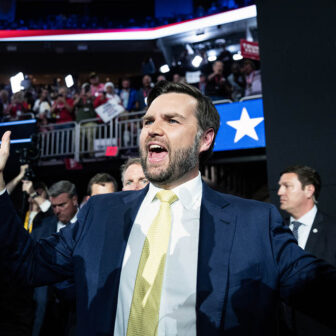EARLIER this year, the US and Japanese governments agreed to transfer around 9000 American marines from the Japanese prefecture of Okinawa to Guam and elsewhere in the Asia-Pacific. The two countries were trying to make some progress on the wider issue of US military “realignment” in Okinawa and Japan more generally, but without relocating the US Marine Corps Air Station Futenma from one part of Okinawa to another.
Back in 2006, when the United States and Japan agreed on the “roadmap” for this military realignment, the relocation of Futenma – away from the built-up city of Ginowan to the Camp Schwab area in the less-populated northeast – was intended, together with the marines transfer and other changes, to reduce the impact of America’s military presence on the everyday lives of Okinawans.
The new facility at Camp Schwab would be based around two runways forming a V-shape across Cape Henoko and protruding into Oura and Henoko Bays. Construction, which was meant to be completed by 2014, is yet to begin, however. And where public sentiment was previously split, Okinawan opinion today is shifting from simply opposing Futenma’s ongoing presence in Ginowan to also opposing its relocation anywhere else in the prefecture. For most Okinawans, the only acceptable relocation is outside Okinawa. But now that the transfer of marines has gone ahead regardless of the progress made on the relocation of Futenma, the airbase is likely to remain where it is for the foreseeable future.
Events in Okinawa over the past couple of months have reinforced how complex and intractable the many issues surrounding the US military realignment have become. The alleged rape of a woman on 16 October by US sailors has led to outrage in Japan and recalls the rape of a twelve-year-old girl by three US military personnel in September 1995. And in September of this year, the scheduled deployment of twelve American MV-22 Osprey vertical take-off and landing aircraft to the Futenma base was the subject of large demonstrations because of safety concerns.
THE roadmap agreement, it should be remembered, was not a sudden development. It was more than a decade prior to the May 2006 agreement, in February 1996, that the two governments first raised the Futenma issue at the highest level – during a meeting between prime minister Hashimoto Ryutaro and president Bill Clinton at Santa Monica in the United States. A subsequent report laid out the idea of moving the base (or at least those parts that couldn’t be absorbed elsewhere), with the move to be completed within “five to seven years” (that is, 2003 at the latest).
One of the key reasons why Hashimoto and Clinton were discussing Futenma at their meeting was that, in the wake of the 1995 rape, Okinawan governor Ota Masahide had rejected an application for lease extensions for a number of US military facilities in Okinawa. Ota’s decision caused dismay in both Tokyo and Washington. In particular, the decision jeopardised the legal basis of the leases and thus the alliance, at least until the central government applied sufficient legal and financial pressure to force the governor to reverse his position. In 1997, the central government, led by the Liberal Democratic Party, or LDP, consequently amended the laws that gave the governor a central position in the base-leasing process, establishing instead the national government’s right to override local objections to lease renewals. Hashimoto noted in the Diet (Japanese parliament) at the time that, were Japan unable to obtain the land, it could “cause a rift in Japan–US relations.”
Raising the Futenma issue at Santa Monica, however, proved far easier for the two governments than actually agreeing to and then implementing a plan for the base’s relocation. Even when the Japanese government finally signed the roadmap in 2006, it appeared unable to obtain Okinawan assent to the plan.
Yet dissent in Okinawa is not universal. Successive Okinawan governors have wavered over the relocation plan, sometimes offering support but on other occasions opposing either certain details or the entire proposal. A number of factors have contributed to this pattern: the long history of base problems in Okinawa, the prefecture’s sense of distance from the rest of Japan, and a number of political and social differences within Okinawa itself. Even when opposition to the bases in Okinawa is high, many in the community remain supportive of their presence since they make a living from base-related industry, services and leasing arrangements.
Okinawan attitudes are shaped as much by the prefecture’s relations with the central government as by its relationship with the United States. For instance, the central government’s reputation in the eyes of Okinawans was greatly damaged by the Ministry of Education’s decision in 2007 to excise sections in history textbooks regarding the role played by the Imperial Japanese Army in Okinawans’ mass suicides during the second world war.
Some of the problems worsened when the Democratic Party of Japan came to power in September 2009; in fact, by early 2010 the realignment process seemed to have broken down entirely. Prime minister Hatoyama Yukio promised the Okinawans that, if they were opposed to moving Futenma somewhere else inside the prefecture, the government would work to shift it outside the prefecture instead. In terms of delivering his promise, however, Hatoyama failed miserably. The US administration reacted angrily to his unilateral decision to revisit the roadmap agreement, and the ensuing standstill compelled the prime minister to retreat to the old position of accepting the roadmap. Hatoyama resigned soon after.
RECENT events in Japan – notably the tragedy of the earthquake, tsunami and nuclear disaster in March 2011 – have overshadowed concerns about the US military presence in Okinawa. But the problems, as the last month has shown, haven’t gone away. When prime minister Noda Yoshihiko reshuffled his cabinet in January this year, he was forced to replace defence minister Ichikawa Yasuo because of comments the minister made about Okinawa. By publicly stating that he was not familiar with the 1995 rape case, Ichikawa had quickly become the subject of outrage in Okinawa and a censure motion by the opposition LDP in the upper house.
But when Noda visited Okinawa the following month, he still failed to obtain the backing of governor Nakaima Hirokazu for the roadmap. Noda attempted to persuade the governor that the Henoko plan would be the only way to solve the impasse, but Nakaima steadfastly maintained his position that the base should be relocated outside the prefecture.
From then until the alleged rape in October, the Osprey deployment to Futenma took up most media attention. With a far greater flight range and the capacity to be refuelled in mid-air, the MV-22 Ospreys are meant to replace the older CH-46 Sea Knight helicopters. They can cover key potential flashpoints in Northeast Asia, notably the Senkaku Islands, which have been the subject of recent Sino-Japanese tensions (and are known as the Diaoyu in China).
Okinawans, who have experienced numerous military-related accidents over the years, are concerned about the Ospreys’ safety, even if they are considered to be a significant upgrade. The 2004 crash of a CH-53 Sea Stallion helicopter into Okinawa International University, near the Futenma base, led to numerous protests and remains contentious. The accident was a watershed event, described by William Brooks, an academic and former US diplomat, as a “symbol of the US base problem in Okinawa.”
According to Tanji Miyume, a specialist in Japanese politics and a visiting fellow at the Australian National University, local opponents have long been deeply concerned about the possible deployment of the Ospreys. Whatever their capabilities, they have suffered a number of well-publicised crashes or emergency landings in the lead-up to their Okinawan deployment. In April, an Osprey crashed in Morocco, and the plans for deployment were delayed; since then, further accidents have occurred in Florida and North Carolina. As a result, the deployment was a hot issue for the June 2012 prefectural assembly elections in Okinawa; groups that were hostile to the Futenma relocation plan and the Osprey deployment – even more hostile than Nakaima – did especially well at the elections. In July, Nakaima called on the central government to stop the deployment until further investigations into the Ospreys’ safety were carried out.
One result of all this has been a significant increase in anti-Osprey protests. Indeed, Okinawan opposition to the Osprey deployment appears to be generally on the rise, suggesting that further progress on resolving wider base problems may remain impossible for some time. Around 5000 people protested against the deployment in June this year; tens of thousands attended a major anti-Osprey rally in early September; and when the first six Ospreys arrived at the Futenma base in early October, they were met by protesters.
Then the alleged rape took place, meaning that tensions in Okinawa, already inflamed by the Osprey deployment, could easily rise further. Japan’s central government has summoned the US ambassador to lodge its protest, while prime minister Noda, defence minister Morimoto Satoshi and foreign minister Genba Koichiro have publicly expressed their anger over the incident. Nakaima has described the alleged rape as “insane” and called for reform of the Status of Forces Agreement (the legal framework under which America’s military personnel operate in a host country). The prefectural assembly has adopted a unanimous resolution expressing its “burning resentment” over the alleged crime.
CAN these problems actually be resolved? Okinawa’s troubles are so intractable because they go to a dilemma at the heart of Japanese grand strategy and the United States–Japan alliance itself: burden sharing.
Japan has three principal options for basic national defence. First, it might continue to rely on the United States and keep the bases, with some realignment but largely as they are. Second, it might further develop its own military capabilities and thus reduce the need for such a large US presence and associated bases in Japan. Third, it might adopt a policy of unarmed neutrality in response to any conflicts and thus eliminate, in theory at least, the need for any military capabilities, American or Japanese.
Japan has never seriously attempted the third option, even at the height of the Cold War, and has in any case moved further away from this choice over the past decade. Moreover, given the unstable nature of the Asia-Pacific today – and Japan’s various territorial and historical problems in the region – such an approach would appear highly impractical.
Yet the second option also remains problematic, both ly and domestically. A military expansion by Japan would likely add further instability to the already tense regional environment and could prompt significant responses from other Asian powers, such as China and North Korea. Short of a major crisis, it remains a major project (even if the nationalist Abe Shinzo becomes prime minister once again).
Accordingly, Japan continues to stick with the first option. Indeed, the alliance remains popular and America’s security guarantee is still welcomed. The central bargain that has so successfully underpinned the alliance – that Japan hosts the United States in return for America’s security guarantee – still has great appeal for both sides. Japan, for instance, is happy that the United States considers that the Senkaku Islands fall within the scope of the security treaty.
The dilemma is that this option contains the seeds of its own undoing in Okinawa. So long as Japan prefers the alliance option, but continues to be seen in Okinawa as unwilling or unable to spread the associated base burden more widely through the country, the alliance will suffer ongoing reputational damage. Accidents and crimes in the prefecture fuel Okinawan discontent over the US military presence and the central government’s negligence, perceived or otherwise.
Robert D. Eldridge, a historian and civilian official for the Marine Corps in Okinawa, talks of a “vicious cycle” in the domestic politics of the basing issue, whereby discussion gradually becomes more contentious and emotional, with little place for compromise. If such a cycle were allowed to persist, it could conceivably weaken the United States–Japan relationship to a point where the viability of this central bargain might be questioned. Under such a scenario, Japan would consider itself unable to support such an ill-behaved sponsor, while America would no longer be willing to defend such a fractious client. The breakdown in this bargain would in turn weaken America’s position in the region while pushing Japan towards the kind of rapid security “normalisation” that could produce the very tensions in the Asia-Pacific that the two allies are hoping to avoid.
A fourth option would be to maintain the US presence but spread the base burden more evenly across the country. The policy of realigning the US military presence in Japan, including relocating the functions of bases in Okinawa to mainland Japan or Guam, has been an important step in this direction.
There are significant obstacles to this process, however. A greater emphasis on the East China Sea region in US and Japanese strategies – illustrated by America’s “pivot” to Asia and Japan’s new “dynamic defence” doctrine – arguably increases Okinawa’s strategic importance. Meanwhile, “nimbyism” in Japan makes it extremely difficult to move key US bases out of Okinawa to other places around the country. This was well illustrated by the criticism Hatoyama received in 2010 when he considered transferring parts of Futenma elsewhere in Japan.
As the cycle of resentment in Okinawa becomes increasingly entrenched and the regional security environment grows more uncertain, tough choices lie ahead for Japanese policy-makers. •




